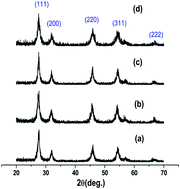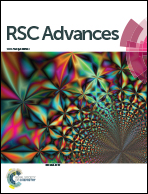Origin of blue emission in ThO2 nanorods: exploring it as a host for photoluminescence of Eu3+, Tb3+ and Dy3+
Abstract
Nanorods of ThO2 were synthesized in a reverse micelle technique using cetyl trimethyl ammonium bromide as a surfactant and characterized by X-ray diffraction and transmission electron microscopy. Doping with europium, terbium and dysprosium was performed at a 1.0 mol% level and was confirmed using XRD. Photoluminescence study showed that nanorods of thoria emit blue color on UV-excitation. Lifetime and electron paramagnetic resonance (EPR) spectroscopy showed that this blue emission is because of oxygen vacancy. First principle calculations using projector augmented wave potentials and generalized gradient approximations predicted that the structural relaxation due to neutral and positively charged oxygen defects in bulk thoria leads to symmetric distortion around the vacancy sites and this prediction was experimentally complemented by measuring highly symmetric isotropic signal with g = 1.959 in EPR studies. Density of states analysis showed the presence of defects states mainly attributed to Th d and f states near the conduction band minima for the double positively charged oxygen vacancy. The radiative transitions from these states qualitatively explain blue emission in thoria. On the basis of the time resolved emission data (TRES), it has been inferred that two different types of Ln3+ ions were present in the thoria nanorods: A long lived species (τ ∼ 1.5 ms) was present at cubic site with Oh symmetry and the other was a short lived species (τ ∼ 300 μs) present at the non-cubic site with C3v symmetry. Most of Eu and Tb are distributed in cubic site with Oh symmetry whereas Dy is mainly localized at the non-cubic site with C3v symmetry. Under UV light excitation, ThO2:Ln3+ nanorods show the characteristic f–f transitions of Ln3+ (Eu, Tb and Dy) ions and give bright red, green, bluish-yellow emission, respectively. In addition, multicoloured luminescence containing white emission has been successfully achieved for tri-doped ThO2:Ln3+ phosphors by simultaneous doping with all the three lanthanides ions and adjusting their doping concentrations for the simultaneous luminescence of Ln3+ in the ThO2 host.


 Please wait while we load your content...
Please wait while we load your content...